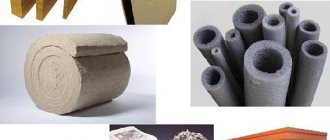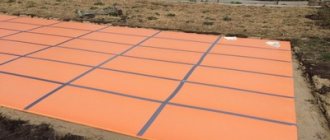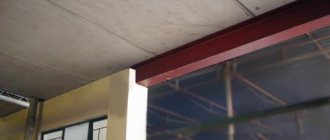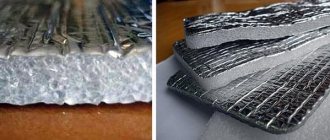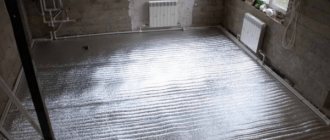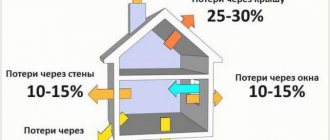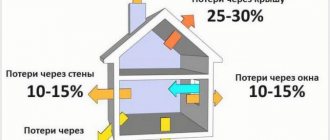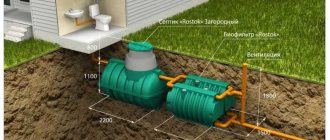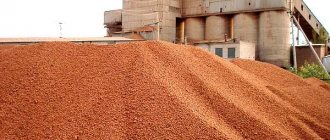There are two ways to avoid heat loss through the ceiling: insulate either the roof or the ceiling. A lot of attention is paid to roof insulation, which is understandable: in this way attic spaces are insulated, which, with due diligence, become residential. They are usually called an attic, although this does not always accurately reflect the essence of things.
The ceiling insulation is located in the shadow of the roof. The editors of the StroyGuru website decided to rectify the situation at least a little and prepared a number of materials on insulating the ceiling with different types of insulation. In the work below we will talk about how ceiling insulation with expanded clay is carried out, how effective it is in terms of heat conservation and justified from an economic point of view.
Pros and cons, material characteristics
Expanded clay is a loose type of insulation. It is produced by firing low-melting clays or shale in a rotating drum. At the exit from the furnace, several fractions of ceramic pellets are obtained.
Types of expanded clay.
Depending on the size and shape of the granules, expanded clay is divided into:
- sand - grain diameter does not exceed 5 mm;
- gravel (not to be confused with quarry gravel) - round granules from 0.5 to 4 cm;
- crushed stone - irregularly shaped pellets measuring 5-10 mm.
In turn, gravel is divided into fractions:
- fine - granule size 5-10 mm;
- average - 10-20 mm;
- large - 20-40 mm.
Advantages and disadvantages
The steady popularity of expanded clay among consumers is explained by its many advantages. Among the advantages :
- relatively low price per m3;
- long service life - 40-60 years;
- fire resistance (class NG);
- resistance to temperature changes;
- high frost resistance;
- light weight of granules;
- Possibility of use in cement mortars;
- environmental Safety;
- biological resistance - does not serve as a basis for the proliferation of fungus and mold;
- is not a rodent habitat;
- simple and convenient installation - all work can be done with your own hands.
The disadvantages include :
- high level of water absorption - 15-25% of weight;
- large thickness of the thermal insulation layer;
- dust formation during insulation work.
When insulating the ceiling with expanded clay, the pros and cons require additional comments and explanations. All this was done in the work “Expanded clay as insulation.”
Characteristics of expanded clay
The physical and technical characteristics of expanded clay depend on the size of the granules. Moreover, they differ greatly from each other in different sources, which is caused by the measurement technique and the type of expanded clay taken for analysis: immediately after firing (absolutely dry) or lying in a warehouse for some time (absorbing moisture from the air). Average data can be viewed here.
Table 1, for comparison purposes, shows the results of testing expanded clay granules of the JSC Expanded Clay Gravel Plant Novolukoml immediately after firing.
Table 1.
| Indicators\Granule size | 10-20 mm | 5-10 mm | 0.5 mm |
| Density, kg/m3 | 289-370 | 300-400 | 500-700 |
| Compressive strength mPa | 1,0-1,8 | 1,2-2,0 | 3,0-4,0 |
| Number of granules with a different size, % | 4 | 8 | 0 |
| Weight loss after 20 freezing cycles, % | 0,4-2,0 | 0,2-1,2 | Not regulated |
| Percentage of crushed granules, % | 3-10 | 3-10 | No |
| Thermal conductivity, W/(m×°K). | 0.0912 | 0.0912 | 0.11 |
A few words about expanded clay
It is very versatile, and the list of its advantages is very long. But at the same time, it must be said about the disadvantages of expanded clay. The most common disadvantage of this material is fragility. That is why working with it requires attentiveness and accuracy. No sudden movement should be allowed, as it can damage the insulation. They, in turn, can lead to the loss of certain qualities by the material, and therefore it will not be possible to create proper insulation of the home. But this problem can be fully solved if you strictly adhere to the instructions for handling expanded clay. The result in this case will please you for many years.
Expanded clay is based on ordinary clay. Like all other ceramics, it goes through a firing process, which hardens the material. Its constituent elements look like ovals or balls of not quite regular shape. There is a separate technology for preparing expanded clay, which is similar to making sand. It is used by quite a few manufacturers.
Although expanded clay accumulates moisture extremely actively, at the same time it does not release it. It is able to absorb even the smallest drops of water. However, this fact can be viewed both from a positive and negative side.
Required materials and tools
To insulate the ceiling with expanded clay you will need:
- expanded clay of different fractions;
- vapor barrier film (type B) or roofing felt;
- vapor barrier membrane (type A or AM);
- timber for laying logs for sealing the insulating layer (not required if the ceiling is hemmed to wooden beams from below);
- antiseptic for treating wooden structures;
- flame retardants - wood fire protection is increasingly used in private construction;
- tape or specialized adhesive tape for sealing seams;
- a thin metal rod for measuring the thickness of the backfill;
- board or rule for leveling expanded clay;
- construction knife;
- construction stapler;
- roulette;
- Chipboard, OSB, plywood for laying over beams or joists for the final floor covering when insulating the attic;
- glass wool or polyurethane foam for sealing cracks in the wall and at the junction of the ceiling and the wall.
Which expanded clay to choose for ceiling insulation
The best thermal insulation properties of coarse gravel granules. However, this does not mean at all that the insulating layer of expanded clay of this fraction has low thermal conductivity. This happens due to the fact that such backfill is not compacted. Therefore, it seems more rational to use smaller fractions of expanded clay.
Through observations and thermal measurements, it was established that the best result is obtained by a layer of expanded clay consisting of 60-70% granules of small (0.5-1.0 cm) and medium (1.0-2.0 cm) fractions with the addition of expanded clay sand with a diameter of 2-3 mm. In this case, the sand is poured in first - it forms a cushion for backfilling the main insulating layer. Some experts approach the problem differently: they believe that regardless of the percentage ratio between gravel and sand, the latter should form a bedding layer 3-4 cm thick.
Calculation of the required layer thickness
It will not be possible to independently calculate what layer of expanded clay is needed to insulate the ceiling. Very complex formulas. Finding an online calculator is difficult, but possible. One of them is presented here.
Builders with experience do not do calculations, but use experience proven over the years: for a wooden house with a ceiling made of pine or spruce, a layer of expanded clay is poured at least 40 cm, for buildings with walls made of another material and concrete floors - at least 30 cm. The figures are given for the regions of central Russia.
For the north of the country, a backfill of at least 50 cm is needed, for the southern regions - at least 20 cm. Let us note in passing that a layer of expanded clay less than 20 cm does not retain heat at all. This is about the same as going outside in 40oC frost in socks, shorts and a T-shirt.
Calculation of material quantity
The amount of expanded clay required is calculated by the formula: V = S x T x 1.2 , where:
- V is the required volume of expanded clay;
- S is the area of the insulated surface;
- T—backfill thickness:
- 1.2 - correction factor for material shrinkage.
Since expanded clay is sold in bags, the resulting volume of expanded clay is divided by the capacity of the bag and rounded up, as a result of which you can see how much ceramic granules to buy.
Peculiarities
Usually there is an attic with a roof above the living space in private houses, then up to 15% of the heat evaporates through the ceiling. In order not to lose a large percentage of warm air, the house is insulated.
Types of insulation granules
- From 0.1 to 50 mm. This is expanded clay gravel, which is used to insulate walls and ceilings.
- From 0.13 to 4 mm. Used as a filler for solutions.
For the strongest heat retention inside the house, the expanded clay layer must be made as thick as possible. Even though the granules have a porous structure and therefore weigh little, the large amount of expanded clay laid on the surface should not be underestimated. The material will press on the ceiling with great force.
To improve the thermal insulation effect, it is better to use expanded clay of small and large sizes together. The base should be a layer of expanded clay, the basis of which is made up of large fractions, and small expanded clay will help to get rid of the large space between the laid material.
Large expanded clay
Small expanded clay
Solving problems when carrying out thermal insulation work
- Excellent sound insulator. Eliminates unnecessary noise from outside and maintains silence in the house.
- Retains warm air in an insulated room even in severe frosts. This air will sink if it does not find bridges for the cold.
- In hot weather, it prevents the penetration of cold outside the building. Therefore, a cool microclimate will remain indoors.
Preparatory work
Ceiling insulation with expanded clay in a private house begins with preparatory work. These include:
- restoration of roof functionality. Nothing should drip or fall from there;
- since the attic is a low space, nothing should stick out from the sheathing and rafter system: nails and screws are either bent or cut flush with a grinder;
- old insulation (in most cases it is glass wool) and the remains of roofing material are removed if repair work is being carried out;
- the condition of the ceiling is inspected;
- all detected cracks and holes between the wall and the floor boards are foamed with polyurethane foam. If necessary, the wooden structure is additionally reinforced with timber;
If necessary, the wooden structure is reinforced.
- the base of the ceiling is first swept and then, preferably, vacuumed;
- the wood is treated, if this was not done during construction (can be seen by the color of the beams and boards - red or pinkish), first with antiseptics and then with fire retardants. Concrete is primed twice;
- steam and waterproofing of the entire insulated surface is carried out. Depending on what material is chosen for this, the type of work will depend. When using roofing felt - waterproofing, polyethylene film or special membranes - vapor barrier. But the main purpose of the film or roofing felt is still a little different - to prevent the smallest expanded clay dust from penetrating the ceiling finish.
The technology for laying vapor barrier films is discussed in the material “Laying a vapor barrier with your own hands.”
Important: when insulating a bathhouse ceiling with expanded clay, a foil film is required. It is laid with a metallized layer towards the room.
Installing roofing felt or vapor barrier film on the wall is mandatory.
Note that the films are laid correctly across the beams, and not along, in a boat, as some theorists advise. At the same time, the overlap is at least 15 cm, and not 3-5 cm, as can be found in the recommendations. The film or roofing felt on the walls should ideally extend to the height of the backfill. However, 12-15 cm will be enough if there is not enough roofing felt or film;
This is not the way to lay roofing felt on a wooden ceiling.
Important: the film or roofing felt must not be stretched. It should go around the beams freely. If this is not done, air pockets will be created in the corners of the junction of the beams and floor boards due to the tension of the insulation under the weight of the expanded clay.
- joining seams are taped;
Properly carried out vapor barrier.
- The vapor barrier is fastened with a stapler with a step between staples of 10-15 cm to the base at the junction with the beam. This operation is best carried out immediately, during the process of rolling out the film;
- It is advisable to seal the staples with tape;
- if an attic is planned in the attic space, then additional sheathing is installed. On a concrete base directly on a vapor barrier film with an edge height of 32 cm (30 cm for expanded clay, 2 cm for a ventilation gap), on a wooden ceiling along beams. The total height of the sheathing: beams and nailed beams is 42 cm (40 cm for backfill, 2 cm for the ventilation gap).
Attention: you can first install the sheathing on a concrete base, and then carry out hydro- or vapor barrier work.
Technology of ceiling insulation with expanded clay
Thermal insulation of the ceiling with expanded clay is carried out according to one scheme:
- between the beams or sheathing cells, a 3-5 cm thick layer of expanded clay sand is poured, after which it is leveled. It is better to carry out work in small areas, 1-2 m2 each;
- Expanded clay of the middle fraction is poured onto the sand in a layer of up to 10-15 cm, after which a section of the ceiling of 1-2 m2 is again covered with sand. And so on over the entire surface;
- the resulting layer is manually, without fanaticism, compacted, after which the expanded clay is filled to the required thickness. When filling without sheathing, the thickness of the layer is checked with a thin metal rod;
- expanded clay is covered with a vapor barrier membrane.
What is expanded clay
At its core, this heat insulator is the most ordinary clay. Small-sized granules are formed during high-temperature processing of clay raw materials. Due to the fact that the source material begins to boil when heated strongly, porous granules are formed, which can serve as an excellent heat insulator.
Several varieties of this insulation are produced, differing in the size of the granules.
In another way, the size of the particles is called “fraction”. The smallest fraction includes grains ranging in size from 0.1 to 5 millimeters. This material is used for backfilling as a heat insulator, up to 5 centimeters thick.
A more popular type of fraction has a size of 0.5 to 4 centimeters and is called gravel. This is what is most often used for insulation.
What's the best way to close it later?
The insulation layer is closed in different ways. Without sheathing, you can lay OSB boards on top and walk on them without fear of disturbing the insulation layer or flat slate. Some experts suggest pouring cement laitance onto the surface, which will strengthen the top layer of expanded clay. There are recommendations to cover the surface with cement mortar using reinforcing mesh. The specific choice is up to the owner's taste.
Scheme of flooring in the attic.
Sheets of plywood, gypsum fiber board or OSB are laid over the sheathing or joists, onto which the finishing floor covering in the attic is then installed. The ventilation gap allows you to avoid contact of the floor with expanded clay, which eliminates various squeaks while walking through the attic space.
Scheme of using cement screed for finishing flooring.
How effective is this type of insulation?
This is how grandfathers, then fathers, and now grandchildren insulated themselves. It seems that according to tradition. But no one has tried to calculate how financially effective and safe it is in terms of TB.
1. Finance. To insulate a wooden house with an area of 35 m2 (this is the area of one log house, but not the house as a whole, since the size of the log is largely limited to 6 m - the standard for logging) you will need about 17 m3 of expanded clay (35 m2 x 0.4 m x 1.2). You will have to pay approximately 20.4 thousand rubles for them. And this is without delivery.
If you lay IZOVOL basalt wool with a thickness of 15 cm, which is more effective in terms of thermal insulation properties, you will have to pay 21.0 thousand rubles. There is a difference in favor of expanded clay, but it will be eaten up by the costs of delivery and purchase of timber for the sheathing, since for expanded clay backfill you will have to additionally purchase wooden beams in the amount of 0.5-1.0 m3. And this is another 3.0-8.0 thousand rubles. additional costs.
2. Weight load. The average density of expanded clay is about 600 kg/m3. With a volume of expanded clay of 17 m3, a mass of insulation weighing about 10 tons will press on the ceiling structure. Whether this is a lot or a little is up to the owners to decide.
What is expanded clay
If we are talking about insulating the ceiling in a private house from the outside, then granulated and fired clay pellets can be considered the number one material for stable characteristics, good thermal insulation and high resistance to all types of thermal and mechanical loads.
The granulate is obtained by high-temperature firing of special types of clay. After water evaporates, a microporous structure is formed, which has high heat and sound insulation properties. Ordinary clay is not used to make expanded clay for residential insulation needs.
Expanded clay material is produced in two fractions:
- Backfill fines or sand. Essentially, these are screenings and fragments of larger granules. The size of the grains of backfill used to insulate the ceiling is in the range of 0.2-6 mm;
- Purchased granulate, up to 4.5 cm in size. This type of expanded clay can also be used for ceiling insulation, but most often the material is used for permanent fills with a thickness of 10 cm or more.
Advice! The mixture contains simply impurities of sand and gravel, so the quality must be checked before purchasing. When purchasing wholesale from a manufacturer of expanded clay granules - sand, it is supplied in bags of 200 kg and 40 kg. The material is usually pure, without impurities. From small suppliers you can buy granules for filling the ceiling mixed with gravel sand.

